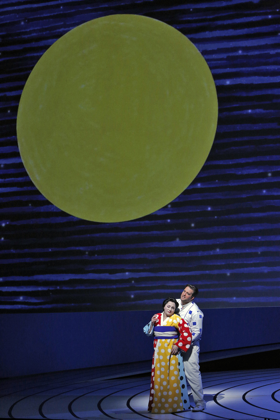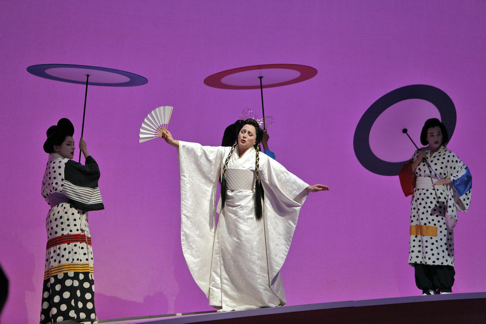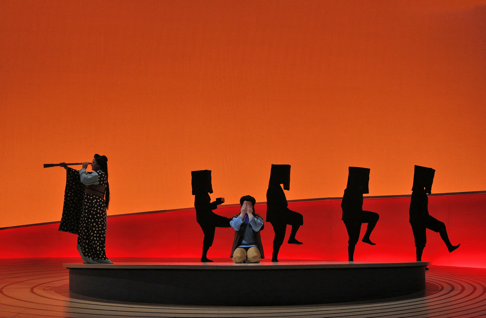
23 Jun 2014
Madama Butterfly in San Francisco
Gesamtkunstwerk, synthesis of fable, sound, shape and color in art, may have been made famous by Richard Wagner, and perhaps never more perfectly realized than just now by San Francisco Opera.
English Touring Opera are delighted to announce a season of lyric monodramas to tour nationally from October to December. The season features music for solo singer and piano by Argento, Britten, Tippett and Shostakovich with a bold and inventive approach to making opera during social distancing.
This tenth of ten Live from London concerts was in fact a recorded live performance from California. It was no less enjoyable for that, and it was also uplifting to learn that this wasn’t in fact the ‘last’ LfL event that we will be able to enjoy, courtesy of VOCES8 and their fellow vocal ensembles (more below …).
Ever since Wigmore Hall announced their superb series of autumn concerts, all streamed live and available free of charge, I’d been looking forward to this song recital by Ian Bostridge and Imogen Cooper.
Although Stile Antico’s programme article for their Live from London recital introduced their selection from the many treasures of the English Renaissance in the context of the theological debates and upheavals of the Tudor and Elizabethan years, their performance was more evocative of private chamber music than of public liturgy.
Evidently, face masks don’t stifle appreciative “Bravo!”s. And, reducing audience numbers doesn’t lower the volume of such acclamations. For, the audience at Wigmore Hall gave soprano Elizabeth Llewellyn and pianist Simon Lepper a greatly deserved warm reception and hearty response following this lunchtime recital of late-Romantic song.
For this week’s Live from London vocal recital we moved from the home of VOCES8, St Anne and St Agnes in the City of London, to Kings Place, where The Sixteen - who have been associate artists at the venue for some time - presented a programme of music and words bound together by the theme of ‘reflection’.
'Such is your divine Disposation that both you excellently understand, and royally entertaine the Exercise of Musicke.’
‘And there was war in heaven: Michael and his angels fought against the dragon; and the dragon fought and his angels, And prevailed not; neither was their place found any more in heaven … that old serpent … Satan, which deceiveth the whole world: he was cast out into the earth, and his angels were cast out with him.’
There was never any doubt that the fifth of the twelve Met Stars Live in Concert broadcasts was going to be a palpably intense and vivid event, as well as a musically stunning and theatrically enervating experience.
‘Love’ was the theme for this Live from London performance by Apollo5. Given the complexity and diversity of that human emotion, and Apollo5’s reputation for versatility and diverse repertoire, ranging from Renaissance choral music to jazz, from contemporary classical works to popular song, it was no surprise that their programme spanned 500 years and several musical styles.
The Academy of St Martin in the Fields have titled their autumn series of eight concerts - which are taking place at 5pm and 7.30pm on two Saturdays each month at their home venue in Trafalgar Square, and being filmed for streaming the following Thursday - ‘re:connect’.
The London Symphony Orchestra opened their Autumn 2020 season with a homage to Oliver Knussen, who died at the age of 66 in July 2018. The programme traced a national musical lineage through the twentieth century, from Britten to Knussen, on to Mark-Anthony Turnage, and entwining the LSO and Rattle too.
With the Live from London digital vocal festival entering the second half of the series, the festival’s host, VOCES8, returned to their home at St Annes and St Agnes in the City of London to present a sequence of ‘Choral Dances’ - vocal music inspired by dance, embracing diverse genres from the Renaissance madrigal to swing jazz.
Just a few unison string wriggles from the opening of Mozart’s overture to Le nozze di Figaro are enough to make any opera-lover perch on the edge of their seat, in excited anticipation of the drama in music to come, so there could be no other curtain-raiser for this Gala Concert at the Royal Opera House, the latest instalment from ‘their House’ to ‘our houses’.
"Before the ending of the day, creator of all things, we pray that, with your accustomed mercy, you may watch over us."
The doors at The Metropolitan Opera will not open to live audiences until 2021 at the earliest, and the likelihood of normal operatic life resuming in cities around the world looks but a distant dream at present. But, while we may not be invited from our homes into the opera house for some time yet, with its free daily screenings of past productions and its pay-per-view Met Stars Live in Concert series, the Met continues to bring opera into our homes.
Music-making at this year’s Grange Festival Opera may have fallen silent in June and July, but the country house and extensive grounds of The Grange provided an ideal setting for a weekend of twelve specially conceived ‘promenade’ performances encompassing music and dance.
There’s a “slide of harmony” and “all the bones leave your body at that moment and you collapse to the floor, it’s so extraordinary.”
“Music for a while, shall all your cares beguile.”
The hum of bees rising from myriad scented blooms; gentle strains of birdsong; the cheerful chatter of picnickers beside a still lake; decorous thwacks of leather on willow; song and music floating through the warm evening air.

Gesamtkunstwerk, synthesis of fable, sound, shape and color in art, may have been made famous by Richard Wagner, and perhaps never more perfectly realized than just now by San Francisco Opera.
It was an Italian opera, the abstract visual images of a Japanese born American and an American fable that converged magically into artistic totality.
The 2006 production itself (design and staging), is from Opera Omaha. It has since traveled to Madison, Dayton, Vancouver, Honolulu, Atlanta, Philadelphia and Charlotte. It would hold the stage in any opera house in the opera world. It is a masterpiece.
The sets and costumes are by Omaha based ceramic artist Jun Kaneko who collaborated with stage director Leslie Swackhamer, a professor at Sam Houston State University (Houston) whose theatrical roots are in Seattle, to create this unique production.
Jun Kaneko works primarily in repeated patterns in two dimensional clay, a visual process that brilliantly found its way into Puccini’s verismo — the abstracted, multi-colored umbrellas of the wedding guests was the kaleidoscope of village life, the sliding panel of black and white squares meant the house. Screens flew in and out on which repeating, jagged lines of growing tension were drawn. These were but some of the patterns that multiplied the joyous and horrific emotional obsessions that are at the base of verismo.
 Act I, Patricia Racette as Butterfly. Photo by Cory Weaver.
Act I, Patricia Racette as Butterfly. Photo by Cory Weaver.
Kaneko creates abstract location (background) in giant swaths of solid color — a golden yellow for the marriage, this color carried through the opera by the golden trousers of Trouble, reds and blues for the American presence, and finally brilliant red for blood, in a dripping image that mirrored the neck seppuku committed by the Butterfly standing just below. These were some of the colors that conveyed the powerfully contrasting forces of verismo.
San Francisco Opera’s Nicola Luisotti was in the pit. This powerful musical presence usually dominates the War Memorial stage. However here the tyrannical maestro met his match — the evolving visual statements riveted our eyes to the stage, diva Patricia captivated our emotions. The maestro did no more than hold us in thrall to this masterwork. It was what great operatic conducting can be. And very seldom is.
 Act II vigil. Photo by Cory Weaver.
Act II vigil. Photo by Cory Weaver.
This was the performance in its finest moments.
Soprano Patricia Racette no longer has the bloom of voice to create the Act I Butterfly or to deliver a resplendent “un bel di.” But she has gained vocal force and darker colors to execute with soul-wrenching power the words that take her gently and brutally to sacrifice and suicide.
Patricia Racette’s Butterfly has been legend for many years. It is a role she is not likely to keep in her voice much longer.
Mezzo soprano Elizabeth DeShong portrayed a Suzuki that could easily become legendary as well. She possesses a lyric mezzo voice in full flower, and a presence that offers an expanded dimension of character for roles like Suzuki and Cenerentola (her Glyndebourne debut) and trouser roles like Hansel (Chicago) and Maffio Orsini (ENO and SFO).
Baritone Brian Mulligan made an adequate Sharpless but did not resonate with the stature of the Racette Butterfly. The Pinkerton was tenor Brian Jagde, a recent Adler Fellow who does not have the refinement necessary to appear on a major stage (the War Memorial claims it is). It was a raw performance, made embarrassing by the strutting onto the stage apron (and even upon the prompter box) to attempt to impress us with his high notes. This young tenor will perform Pinkerton at Covent Garden, casting that is surely manifestation of artistic anti-Americanism. Current Adler Fellow Julius Ahn is not a big enough performer to fill the Goro pants in a major production.
Michael Milenski
Casts and production information:
Cio-Cio-San: Patricia Racette; Lt. B.F. Pinkerton: Brian Jagde; Suzuki: Elizabeth DeShong; Sharpless: Brian Mulligan; Goro: Julius Ahn; Kate Pinkerton: Jacqueline Piccolino; Prince Yamadori: Efrain Solis; The Bonze: Morris Robinson; Commissioner: Hadleigh Adams. Chorus and Orchestra of San Francisco Opera. Conductor: Nicola Luisotti; Stage Director; Leslie Swackhamer; Production Designer: Jun Kaneko; Lighting Designer: Gary Marder. War Memorial Opera House, June 15, 2014.